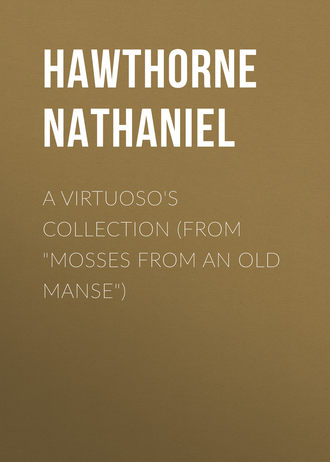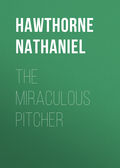
Натаниель Готорн
A Virtuoso's Collection (From "Mosses from an Old Manse")
We now passed to the next alcove of the hall, in which was a multitude of stuffed birds. They were very prettily arranged, some upon the branches of trees, others brooding upon nests, and others suspended by wires so artificially that they seemed in the very act of flight. Among them was a white dove, with a withered branch of olive-leaves in her mouth.
“Can this be the very dove,” inquired I, “that brought the message of peace and hope to the tempest-beaten passengers of the ark?”
“Even so,” said my companion.
“And this raven, I suppose,” continued I, “is the same that fed Elijah in the wilderness.”
“The raven? No,” said the virtuoso; “it is a bird of modern date. He belonged to one Barnaby Rudge, and many people fancied that the Devil himself was disguised under his sable plumage. But poor Grip has drawn his last cork, and has been forced to ‘say die’ at last. This other raven, hardly less curious, is that in which the soul of King George I. revisited his lady-love, the Duchess of Kendall.”
My guide next pointed out Minerva’s owl and the vulture that preyed upon the liver of Prometheus. There was likewise the sacred ibis of Egypt, and one of the Stymphalides which Hercules shot in his sixth labor. Shelley’s skylark, Bryant’s water-fowl, and a pigeon from the belfry of the Old South Church, preserved by N. P. Willis, were placed on the same perch. I could not but shudder on beholding Coleridge’s albatross, transfixed with the Ancient Mariner’s crossbow shaft. Beside this bird of awful poesy stood a gray goose of very ordinary aspect.
“Stuffed goose is no such rarity,” observed I. “Why do you preserve such a specimen in your museum?”
“It is one of the flock whose cackling saved the Roman Capitol,” answered the virtuoso. “Many geese have cackled and hissed both before and since; but none, like those, have clamored themselves into immortality.”
There seemed to be little else that demanded notice in this department of the museum, unless we except Robinson Crusoe’s parrot, a live phoenix, a footless bird of paradise, and a splendid peacock, supposed to be the same that once contained the soul of Pythagoras. I therefore passed to the next alcove, the shelves of which were covered with a miscellaneous collection of curiosities such as are usually found in similar establishments. One of the first things that took my eye was a strange-looking cap, woven of some substance that appeared to be neither woollen, cotton, nor linen.
“Is this a magician’s cap?” I asked.
“No,” replied the virtuoso; “it is merely Dr. Franklin’s cap of asbestos. But here is one which, perhaps, may suit you better. It is the wishing-cap of Fortunatus. Will you try it on?”
“By no means,” answered I, putting it aside with my hand. “The day of wild wishes is past with me. I desire nothing that may not come in the ordinary course of Providence.”
“Then probably,” returned the virtuoso, “you will not be tempted to rub this lamp?”
While speaking, he took from the shelf an antique brass lamp, curiously wrought with embossed figures, but so covered with verdigris that the sculpture was almost eaten away.
“It is a thousand years,” said he, “since the genius of this lamp constructed Aladdin’s palace in a single night. But he still retains his power; and the man who rubs Aladdin’s lamp has but to desire either a palace or a cottage.”
“I might desire a cottage,” replied I; “but I would have it founded on sure and stable truth, not on dreams and fantasies. I have learned to look for the real and the true.”
My guide next showed me Prospero’s magic wand, broken into three fragments by the hand of its mighty master. On the same shelf lay the gold ring of ancient Gyges, which enabled the wearer to walk invisible. On the other side of the alcove was a tall looking-glass in a frame of ebony, but veiled with a curtain of purple silk, through the rents of which the gleam of the mirror was perceptible.
“This is Cornelius Agrippa’s magic glass,” observed the virtuoso. “Draw aside the curtain, and picture any human form within your mind, and it will be reflected in the mirror.”
“It is enough if I can picture it within my mind,” answered I. “Why should I wish it to be repeated in the mirror? But, indeed, these works of magic have grown wearisome to me. There are so many greater wonders in the world, to those who keep their eyes open and their sight undimmed by custom, that all the delusions of the old sorcerers seem flat and stale. Unless you can show me something really curious, I care not to look further into your museum.”
“Ah, well, then,” said the virtuoso, composedly, “perhaps you may deem some of my antiquarian rarities deserving of a glance.”
He pointed out the iron mask, now corroded with rust; and my heart grew sick at the sight of this dreadful relic, which had shut out a human being from sympathy with his race. There was nothing half so terrible in the axe that beheaded King Charles, nor in the dagger that slew Henry of Navarre, nor in the arrow that pierced the heart of William Rufus, – all of which were shown to me. Many of the articles derived their interest, such as it was, from having been formerly in the possession of royalty. For instance, here was Charlemagne’s sheepskin cloak, the flowing wig of Louis Quatorze, the spinning-wheel of Sardanapalus, and King Stephen’s famous breeches which cost him but a crown. The heart of the Bloody Mary, with the word “Calais” worn into its diseased substance, was preserved in a bottle of spirits; and near it lay the golden case in which the queen of Gustavus Adolphus treasured up that hero’s heart. Among these relics and heirlooms of kings I must not forget the long, hairy ears of Midas, and a piece of bread which had been changed to gold by the touch of that unlucky monarch. And as Grecian Helen was a queen, it may here be mentioned that I was permitted to take into my hand a lock of her golden hair and the bowl which a sculptor modelled from the curve of her perfect breast. Here, likewise, was the robe that smothered Agamemnon, Nero’s fiddle, the Czar Peter’s brandy-bottle, the crown of Semiramis, and Canute’s sceptre which he extended over the sea. That my own land may not deem itself neglected, let me add that I was favored with a sight of the skull of King Philip, the famous Indian chief, whose head the Puritans smote off and exhibited upon a pole.
“Show me something else,” said I to the virtuoso. “Kings are in such an artificial position that people in the ordinary walks of life cannot feel an interest in their relics. If you could show me the straw hat of sweet little Nell, I would far rather see it than a king’s golden crown.”
“There it is,” said my guide, pointing carelessly with his staff to the straw hat in question. “But, indeed, you are hard to please. Here are the seven-league boots. Will you try them on?”







